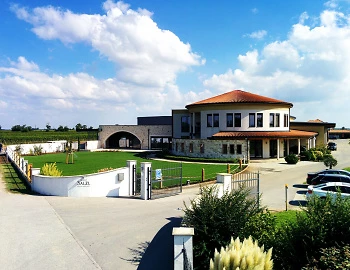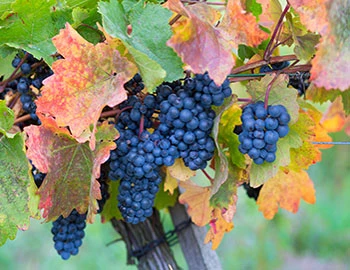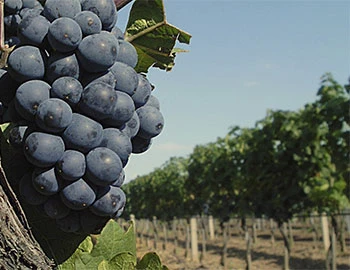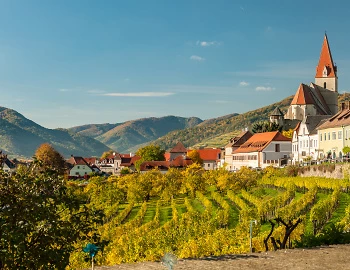
Zweigelt Reserve 2019
QWt Burgenland, Salzl Seewinkelhof, 3000 ml
| Grape variety: | Zweigelt |
| Producer: | Salzl |
| Origin: | Austria / Burgenland / Neusiedlersee |
| Other bottle sizes: | |
| Other vintages: |
Description
Wonderfully delicate fruit notes on the nose, ripe sour cherries, stewed cherries, blueberries, a hint of tobacco notes as well as fine toasted aromas, candied orange zest and finely spicy in the background. The wonderful, creamy mouth filling makes enormous pressure, pure fruit bomb, lots of melting with delicately supporting acidity, salty minerality, juicy, ripe cherry fruit, red forest berry confit, fine tannins, chocolaty touch, plums in the finish, balanced texture, inviting drinking flow, delicate roasted aromas, some coconut, long spicy finish. A wonderful and typical Zweigelt that guarantees enormous drinking pleasure!
Attributes
| Origin: | Austria / Burgenland / Neusiedlersee |
| Grape variety: | Zweigelt |
| Ripening potential: | 2 to 7 years |
| Drinking temperature: | 16 to 18 °C |
| Food Pairing: | Calf's kidneys with mustard sauce, Rabbit ragout with olives, Fegato alla veneziana |
| Vinification: | long must fermentation, fermentation in steel tank |
| Harvest: | strict selection |
| Maturation: | in used barriques |
| Maturation duration: | 12 months |
| Volume: | 13.5 % |
| Note: | Contains sulphites |
Salzl
The Austrian winery Salzl Seewinkelhof is located in Illmitz, surrounded by the picturesque lakes and plains of the Neusiedlersee-Seewinkel National Park in Burgenland. A good hour’s drive from Vienna lies this family winery that also provides comfortable 4-star accommodation in an attached guesthouse with a pool.
The history of the winery dates back to 1840. Josef Salzl restructured the winery in the 1980s, focusing on the production of high-quality red wines and thus laying the foundation for today’s success. Since 2005, his son Christoph has also been fully involved in the operation of the winery. He is taking over the business step by step in order to continue the family tradition. Three generations are currently working hand in hand to produce authentic wines with the greatest passion and care according to the motto “enjoyment and joie de vivre”.

Zweigelt
Flatterer with a backbone
The Zweigelt is an Austrian original. Fritz Zweigelt crossed it in 1922 at the Klosterneuberg Orchard and Viniculture School ("Obst- und Weinbauschule Klosterneuburg") from the red varieties Blaufränkisch and Saint Laurent. Zweigelt's main quality is being marvellously drinkable. With its exuberant berry fruit and juicy structure, it fits like no other to the pleasurable lifestyle of our Austrian neighbours. One thinks, for example, of a hearty Brettjause in the wine tavern. It can, however, also assemble well with other grape varieties, and expand in wooden barrels for more backbone. No wonder it is the most planted grape variety in Austria. One curiosity: the Japanese island of Hokkaido grows 230 hectares of Zweigelt.

Burgenland
Burgenland: Reds, sweets and other wonders
Burgenland is often referred to in Austria as the new wine world. In fact, wines – with exceptions like the nobly sweet Ruster Ausbruch – were almost entirely unknown here 20 years ago. Today, the most substantial red wines in Austria mature here. And the sweet wine scene is also stronger than ever before. Even the whites – for instance, in the Leitha Mountains – are on the upswing. The basis for this wine wonder are the various terroirs that overlay the land in a complex patchwork.

Austria
Austria – Sumptuous culture, accessible to all
Austria is characterized by unbelievable topographical diversity. A flat steppe in the east, forests and hills in the Alpine regions, wetlands and Mediterranean landscapes in the south. This in addition to a rich tradition and even greater love. It’s no surprise that the Romans found joy on this patch of Earth and cultivated wine growing. Austrian wine is not abundant, but it is high quality.

